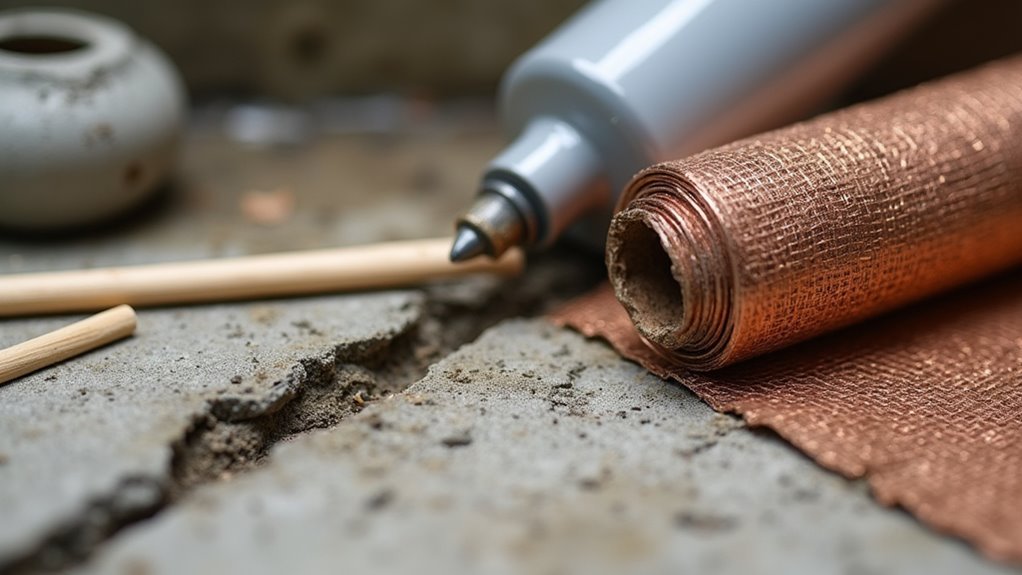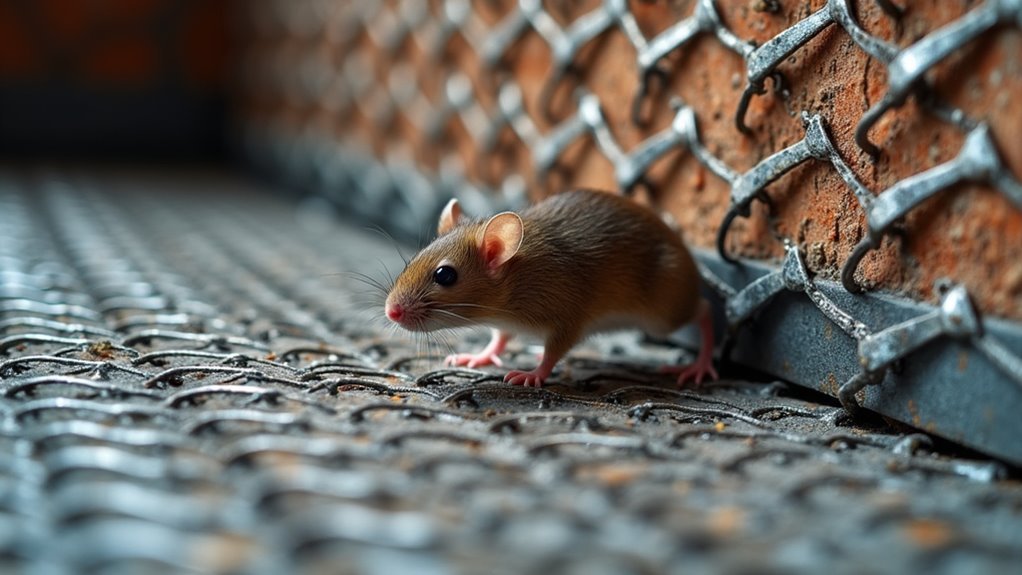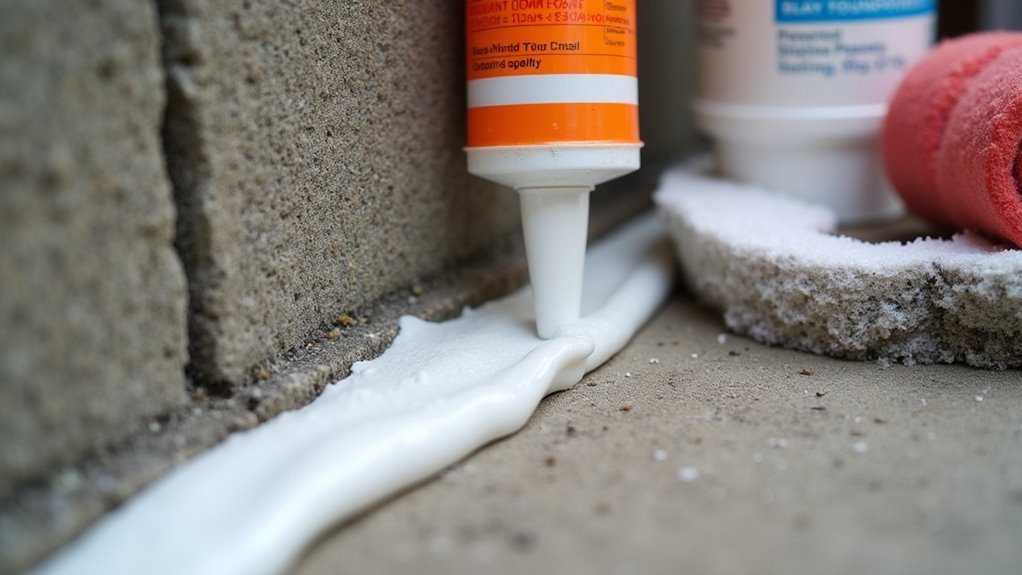You’ll need steel wool as your primary defense, since mice can’t chew through its tightly packed fibers. Combine it with high-quality caulk for smaller cracks and concrete patching compounds for gaps larger than one inch. Metal mesh or hardware cloth works well for areas requiring ventilation while blocking entry points as small as 1/4 inch. These materials create an impenetrable barrier when applied correctly, and proper preparation techniques guarantee maximum effectiveness.
Understanding Common Foundation Entry Points for Mice

While mice might seem too large to fit through tiny openings, they can actually squeeze through foundation cracks as small as 1/4 inch, making thorough inspection your first line of defense.
You’ll need to examine gaps around utility lines, which often escape notice during routine checks.
Don’t overlook unsealed weep holes in brick foundations—these provide easy access for shelter-seeking mice.
Pay special attention to areas where different building materials meet, such as siding junctions near your foundation, as these spots are frequently inadequately sealed entry points.
Environmental factors and settling create new gaps and cracks over time, so you’ll want to conduct regular inspections.
Identifying these vulnerabilities helps you choose appropriate sealing materials for effective mouse prevention.
Steel Wool: Your First Line of Defense Against Rodent Entry
You’ll find steel wool serves as your most reliable barrier against mice because its tightly packed fibers resist gnawing and create an impenetrable seal in foundation gaps.
When you apply fine-grade steel wool correctly and combine it with caulk or spray foam, you’re creating a dual-layer defense that addresses both small cracks and larger openings.
However, you must inspect and maintain these steel wool seals regularly since even this durable material can degrade over time and compromise your rodent protection.
Steel Wool Application Techniques
Steel wool stands as one of the most effective materials for blocking mouse entry points around your foundation. When sealing gaps, you’ll find that mice can’t chew through steel wool’s tightly packed fibers, making it an effective strategy for small openings around pipes, vents, and foundation cracks.
Start by selecting fine-grade steel wool for tight spaces and coarse-grade for larger openings. Always wear gloves when applying these materials to prevent cuts.
Pack the steel wool firmly into gaps, ensuring there’s no loose material rodents can exploit. For best results, combine with caulk or expanding foam to create a tight seal and add durability.
Schedule regular inspections since moisture causes rusting, which reduces effectiveness over time.
Combining With Other Sealants
Although steel wool provides excellent rodent deterrence on its own, pairing it with complementary sealants creates an even stronger barrier against mouse intrusion. When you combine steel wool with caulk, you’ll seal gaps more effectively while preventing the material from shifting over time. This approach enhances durability and creates extensive preventive measures for your foundation.
| Gap Size | Steel Wool + Primary Sealant | Additional Material |
|---|---|---|
| Small (under ¼”) | Fine steel wool + caulk | None needed |
| Medium (¼” – 1″) | Steel wool + caulk | Metal sheeting |
| Large (over 1″) | Steel wool + concrete patch | Metal backing |
Combining sealants addresses different vulnerabilities simultaneously. While steel wool deters gnawing, caulk prevents air infiltration, and concrete patch provides structural integrity against rodent entry attempts.
Durability Against Mouse Gnawing
When mice encounter steel wool’s tightly woven fibers, they’ll quickly discover why this material stands as your most reliable first defense.
The rough texture and dense composition create an effective barrier that discourages gnawing attempts. Unlike softer materials rodents easily chew through, steel wool’s durability makes it exceptionally challenging for mice to breach.
You’ll find it particularly valuable for sealing gaps and small holes around your foundation where traditional methods fall short. When combined with sealants like caulk, you create an enhanced defense system that’s nearly impenetrable.
However, regular inspections remain essential since steel wool can deteriorate over time. Fine-grade steel wool works best to prevent entry, fitting snugly into tight spaces.
Concrete Patching Compounds for Larger Foundation Gaps
If standard caulks and sealants can’t handle the job, concrete patching compounds offer the heavy-duty solution you need for larger foundation gaps. These compounds create a durable seal that withstands moisture and temperature changes while preventing mice from accessing your home.
| Application Area | Gap Size | Effectiveness |
|---|---|---|
| Concrete foundations | 1-3 inches | Excellent |
| Utility penetrations | 0.5-2 inches | Superior |
| Masonry walls | 1-4 inches | Outstanding |
You’ll need to properly prepare the surface by cleaning and ensuring it’s moisture-free for ideal adhesion. These compounds work best in static locations rather than areas with foundation movement. Schedule regular inspections and maintenance of patched areas to guarantee continued effective pest prevention and seal integrity over time.
Metal Sheeting and Mesh Solutions for Maximum Protection

When you’re dealing with persistent mice problems, metal sheeting and mesh solutions offer the most robust defense against rodent intrusion into your foundation.
You’ll find that steel sheeting provides excellent coverage for larger gaps, while metal mesh and hardware cloth work perfectly for smaller openings that still require airflow.
These durable materials resist gnawing and weather damage, giving you long-term protection that outlasts most other sealing methods.
Metal Mesh Barrier Benefits
Although mice can gnaw through many materials, metal mesh barriers offer unmatched durability that’ll stop rodents in their tracks.
Stainless steel and galvanized wire mesh create a durable physical barrier that effectively blocks rodent entry while resisting gnawing attempts. These solutions excel at helping you seal foundation gaps because they withstand harsh weather conditions without degrading like organic materials.
You’ll appreciate how metal mesh allows ventilation while blocking pests, reducing moisture buildup to prevent mold growth.
When you install metal sheeting with caulk or spray foam, you’ll enhance sealing of larger openings. This thorough approach lets you secure vulnerable entry points around foundations and utility lines, greatly reducing the likelihood of mouse infestations in your home.
Steel Sheeting Installation Methods
Steel sheeting takes metal barrier protection to the next level by covering larger foundation gaps that standard mesh can’t effectively seal.
When you install steel sheeting properly, you’ll create an impenetrable barrier that mice can’t gnaw through, helping you seal your house against rodent entry.
Follow these essential installation steps for maximum protection:
- Secure the foundation – Confirm steel sheeting is securely anchored to prevent movement that creates new entry points.
- Combine with mesh solutions – Use stainless steel mesh alongside sheeting to cover vents while maintaining airflow.
- Overlap edges properly – Overlap sheeting edges and seal with caulk or silicone to eliminate potential gaps.
- Schedule regular inspections – Check for rust or damage that could compromise your barrier’s effectiveness.
Hardware Cloth Applications
Hardware cloth delivers superior foundation protection by combining the flexibility of mesh with the durability of welded wire construction.
You’ll find this material exceptionally effective for preventing mice since its mesh openings measure 1/4 inch or smaller, blocking even tiny rodents from squeezing through gaps.
When installing properly, bury the hardware cloth several inches underground to create a thorough barrier against rodents that might attempt digging.
The gnawing resistant properties guarantee your investment provides long-lasting protection where other materials fail.
You can enhance effectiveness by combining materials – use hardware cloth alongside caulk or concrete patch for complete coverage.
This approach helps you seal foundation gaps thoroughly while the welded wire mesh handles areas requiring flexible yet durable solutions.
Proper Application Techniques for Long-Lasting Foundation Seals

Five essential steps assure your foundation seals withstand years of weather exposure and determined rodent attempts.
1. Clean and prepare surfaces thoroughly – Remove debris, dirt, and old sealants from gaps before application.
Proper surface preparation guarantees maximum adhesion and prevents moisture infiltration that compromises seal integrity.
2. Select appropriate materials for gap size – Use steel wool for smaller openings and concrete patch for larger foundation cracks.
Apply caulk or spray foam evenly, eliminating voids mice could exploit.
3. Follow manufacturer’s curing guidelines – Allow proper drying times for ideal performance and weather resistance against temperature fluctuations.
4. Schedule regular maintenance inspections – Monitor sealed areas for deterioration signs and reapply sealants as needed to maintain effective barriers that deter rodent entry long-term.
Maintenance and Inspection Schedule to Keep Mice Out
While proper sealing techniques form your first line of defense, establishing a consistent maintenance routine guarantees mice can’t exploit deteriorating barriers over time.
You’ll need to conduct foundation inspections twice yearly, focusing on utility line areas where gaps commonly develop. Create a checklist tracking your sealants’ condition, including caulk, steel wool, and concrete patches.
Monitor high-risk areas like basements and crawl spaces for mouse activity signs such as droppings or gnaw marks. When you identify damaged sealing materials or new gaps, schedule immediate repairs since mice squeeze through quarter-inch openings.
Keep detailed maintenance logs noting materials used and any changes in sealed areas. This documentation helps you plan future inspections and track which foundation repairs need attention.
Frequently Asked Questions
How Do You Seal Gaps to Keep Mice Away?
You’ll seal gaps using steel wool for small holes, silicone caulk for cracks, expanding foam for larger openings, weatherstripping around doors and windows, and concrete patch for foundation cracks.
What Sealant Can Mice Not Chew Through?
You’ll find mice can’t chew through steel wool, copper mesh, or concrete-based sealants. These materials provide durable barriers that resist rodent gnawing, making them your best options for permanent gap sealing solutions.
What Is the Best Gap Filler for Rodents?
You’ll find steel wool combined with caulk works best for rodent gap filling. Steel wool’s tough fibers discourage chewing while caulk seals permanently. For larger openings, you’ll want expanding foam or concrete patch instead.
What to Put Under a Door Gap to Keep Mice Out?
You’ll want to install door sweeps at the bottom of your door to create an effective barrier. They’re specifically designed to seal gaps and prevent mice from squeezing through those small spaces underneath doors.
In Summary
You’ve got several effective options to seal foundation gaps against mice. Steel wool works perfectly for small openings, while concrete compounds handle larger cracks. Don’t overlook metal sheeting for maximum protection. Remember, proper application technique makes all the difference in creating lasting seals. You’ll need to inspect your foundation regularly and maintain these barriers to keep mice out permanently. Consistent monitoring guarantees your home stays rodent-free year-round.





Leave a Reply